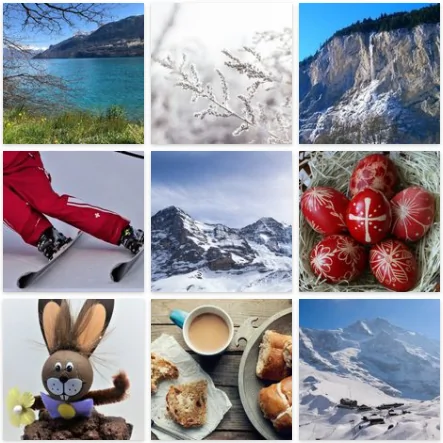|
In mid January, the bell of the Grindelwald village church strikes twelve o'clock just before a single ray of sunshine will appear on the church square and then again in mid-November.
The sun star streams from behind the Eiger after passing through a hole in the rock about two by three meters in size to make the star. The rock window is called Martins Loch (hole) and is said to have been formed this way…… Once upon a time, a giant named Martin once lived at the foot of the Eiger. In those days, there were no glaciers in the valley. The Eiger and Mettenberg stood next to each other, and there was no five-hundred-meter-wide canyon between Bäregg and Bonerren to let the ice flow in between. Only a small gap, a hole in the rock, let temporarily, the melt water pass through and it was mixed with ice blocks, that then dammed behind the rock barrier. Then the glacier creek roared in high waterfalls down into the rocky steps into the forest. But the pressure of the water and ice could get too powerful. Then the dam would break here and there, and a devastating flood would carry away and destroy all that was in the way; houses and barns, humans and animals. Martin, was a man large in stature, some called him a giant as his strength was well known. He lived in a cave at the foot of the Eiger rock wall. The cave is still there today. Martin, seeing the oncoming devastation, risked his life in these times of glacial water outbreaks as he cared for the residents of the valley. Rather than always taking these risks, Martin decided to remedy the problem. Martin climbed up into the narrow gap, leaned back against the Mettenberg side, and using his feet and walking stick, he pushed back and stemmed the waterflow against the Eiger. With a powerful pounding and pressing, a crash went through the mountains, that forced them apart. Finally, it was done. Martin had made the hole gape open so far now, that the water had sufficient space to rush on through without endangering the people living beneath. In his tremendous effort, Martin had bumped a hole with is stick into the Eiger. And it is still there. .Source: Challigroosi and Muggestutz, Grindelwald Sagas, collected and rewritten by Rudolf Rubi (1981/2018) Inspired by this natural phenomenas all his life, the Grindelwald photographer, Speedy Füllmann, knows the best places to photograph this stunning spectacle. On certain days Speedy says that he sees the sun shining through the Martinsloch from his terrace. "The mood is different every time”, he says, “Sometimes there are clouds in the background, sometimes the sun casts a shadow on them, and sometimes you can see snowdrifts in the picture". Speedy does not use star filters or Photoshop effects. https://www.speedyfoto.ch/ 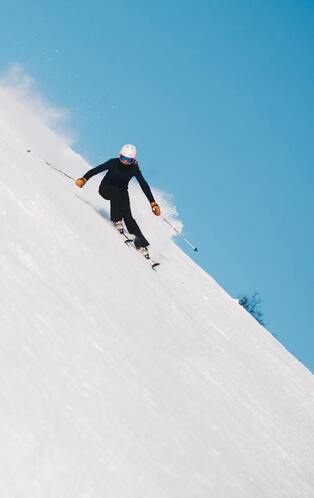 Being able to control your speed is the most crucial secret. Ripping down the Schilthorn like James Bond is not going to impress anyone if you fall and take 3 people with you breaking bones and worse. Position and balance are connected to controlling speed and choosing your path down the slope. • Keep your weight on the balls of your feet. • Stay balanced over the centre of the skis. • Keep your body in a stable ‘ready position’ over the middle of the skis. This means all of your skiing joints (ankles, knees and hips) are ‘flexed’ (soft). • Keep your hands in front of you and relaxed. When your hands are in the correct position, you will be able to pole plant using only your wrist. If you need to reach forwards with your arm or shoulder, your hands are too far back. • Look where you want to go. Staying flexed allows your joints to be shock absorbers without damaging your joints. Do not stiffen or Set your muscles. Try and keep your body at a 90-degree angle to the slope and stay over the centre of the skis. You will need to move forwards with the increasingly steep terrain, otherwise you will be leaning back. Finish a turn with your weight balanced over the outside (or ‘working/downhill’) ski. The inside edge of the outside ski has the best grip to the snow. A short turn will help control your speed. Make it a quick short turn. You can always skid at the start of your turn to help slow yourself down until you get more confident. To make your ski grip early in the turn, think about putting more weight on the outside ski earlier in the turn to give it more pressure and then it should make a more rounded turn. The longer your skis face down the slope, the faster you will go. So make many short quick turns and look where you are going. Sometimes the temperatures have been so cooooold at night and the snow grading machines having been hammering away, that by the time you reach the start of a run at 8:30, it is hard packed and icy. Often the machines makes ridges in the snow with their caterpillar feet. These be an edge catcher on a cold morning.
Also at higher altitude when the snow catches hot afternoon sun, like at Wixi or Eiger Nord Wand, it will thaw and freeze overnight when the temperature drops. Another factor to consider is that after a windy storm the loose snow is blown off exposing very hard or icy surfaces. We all know that shearing sound, like fingernails on a chalk borad. Then ensing muscles and the pain of a fall as if on concrete. If your ski edges are dull, rusty or dinged, they are basically ‘blunt’ and it will not helpy out to turn or stop on ice or hard packed snow. So stay tuned! If you’ve been skiing a lot of icy runs, look your edges over daily and file the burrs off. We love our Ski workbench that is also in the ski storage room,, so easy to check edges everyday. Now you have sharp edges, you still need to adjust your body position to help hold your edges and keep your skis from slipping out from under you. On ice, you want more of your body in the centre and over the centre of your skis so as to keep your edges gripping. Do this by lowering your hips and, bending from the waist, lean your upper body down the fall-line. This movement helps keep your body weight more on the inside edge of your downhill ski all the while leaning your feet and ankles into the hill for edge grip. The best body position for controlling your skis on ice depends on the type of skis you are on - twin-tip, fat, the amount of sidecut, ski length and your body-weight distribution. With all these variables it's necessary to practice on a less steep icy slope until you find that comfort zone. • If you ski with skis close together separate your skis a little more on ice for better stability - but not so far apart that it is difficult to position your weight over the downhill ski. • If the icy area is just a small patch and you see soft snow downhill from the ice ski across the ice maintaining balance and then turn in the soft snow. • When coming to a stop on ice don't try to stop suddenly by digging your edges into the ice. Instead, begin the stop by side slipping to a gradual stop applying gentle pressure to the ski edges. You will hear that prolonged scrapping and know you have side slipped well. • Be confident to plant your poles firmly, otherwise timing, weighting, balance will be lost. Great early quality snow in December!
Powder places to ski are still fresh to be found. Spindrift seen here on top of EM & J. For snow, Spindrift, is defined as fine grained snow being carried by wind or falling. In practice it is usually used to describe the frequent sluffs of snow that fall down steep slopes, gullies, and faces. This occurs frequently during snowfall or warming, but may occur at other times and for other reasons as well. The reason very steep slopes have less of a slab avalanche danger is because the snow tends to fall off frequently enough to avoid an accumulation, in the form of spindrift avalanches. Climbers on steep routes during storms often encounter spindrift at regular intervals. They can even anticipate the next one by keeping an eye on their watch. The intervals will depend on rate of snowfall, winds up above, density of the snow, etc While it can be windy up on the peaks, the ski slopes can be well sheltered. This photo shows the Wixi ski run accessed from Kleine Scheidegg. A popular intermediate run with lots of options and also a choice in white out conditions for its predictability and position. At the working Hydropower powerplant run by EWL in Stechelberg, you can visit the Eco Garden on their trail to see the labelled Flora examples. Although there are no benches, you can bring a blanket to sit on, picnic and enjoy the Weisse Lütchine and the Sefinen Lütchine Rivers after looking through this “compensatory garden”.
Since 1905 the hydropower had come from both the Sefinen Lütschine and the Weisse Lütchine rivers. Since 2005, the use of the Weisse Lütchine was stopped so that it could be preserved as a natural ecosystem and the Eco garden was built around 2013. The Plant produces eco-friendly energy. To some extent, the making of electricity reduces the flow of the river compared to its natural state. This in turn can reduce the quality of habitat for fish and other river animals. Compensation measures that were put into place include this revegetation of the meadow with flowers, creating two ponds for spawning grounds for residents such as frogs. A ‘Fish ladder’ was built to help fish move upstream in their season. The power plant also produces a little Creek of its own which flows back into the main river. You can get to the edge of the Weisse Lütchine and enjoy its gurgling power jumping over rocks and boulders before it meets the Sefinen Lütschine. Some days are just right for a BBQ and you wish you could find one!
There are several free BBQ places around the Lauterbrunnen Valley that also have firewood supplied and rustic tables and chairs. They can be hidden gems to find when the little kids have had enough walking and need to rest. This gives a good time to get the fire burning and coals just right to grill locally made sausages from the Butcher in the middle of Lauterbrunnen. While it takes a little preparation to think ahead to bring some paper and matches and a few “tools”, it is a time to take time and enjoy the experience and the surrounds. Here are a few locations: At the Schmelzofen (Photo) or Smelting furnace from the 17th century, along the track beside the Weisse Lütchine about 10 minutes walk from the Zweilütschinen train station. It is about 30 minutes’ walk from Lauterbrunnen along a gravely path so not so good for strollers from this direction. It is well shaded and the kids can explore the inside of the old oven. GPS 46°37'16.9"N 7°54'13.7"E In Lauterbrunnen there is a Grilling place with stunning views of the valley and of the Staubbachfall and Spiss waterfalls. In fact, the closest waterfall is called Spiss. This is also under some shady trees and along the paved farm road, it is easy for strollers. From the Carpark next to the church, walk past the Staubbachfall after filling up your water bottle at the water fountain there 😊 and keep walking up a slight rise with a dairy on your right you will soon see the Fireplaces and tables on the right. Such a rural scene with the cows usually in the surrounding meadows and the Weisse Lütchine rushing along below. GPS 46°34'57.9"N 7°54'37.4"E Behind the Schilthornbahn cable car station, not far from Stechelberg, is another grilling place wit ha stunning view to the mighty Mürrenbachfall. You can catch the bus to the cable car station and walk over the bridge or walk along the road from Lauterbrunnen past the Staubbachfall for about an hour and when the road becomes a gravelly path for about 200 metres you will soon arrive at the fireplaces on the right. There are toilets at the cable car station and a fresh water fountain ‘mountain style’ at the BBQ place. Lots to look at here with many para gliders landing o nthe grassy area behind the carpark. GPS: 46°33'21.6"N 7°54'02.3"E The fireplace is a little outside of Wengen along the trail towards the Leiterhorn, Burglauenen and Männlichen. The area is a bit hidden as it is behind and above a row of old dark brown traditional barns. There is lots of shade and a forest to play in as well as the view GPS 46°36'44.7"N 7°55'06.4"E Naturally it is like hiking, you want to just leave footprints and a clean plate for the next people. 👣 Bänkli means little seats in Swiss German. There are 9 of them facing the magnificent Staubbachfall on the other side of the Valley that is dropping 300 metres in the middle.
From Wengen train station walk towards the shop called Coop and then right under the railway line. Follow the road to the junction near the Hotel Bären then turn left along a level path past the Schweizerhof and the Chalet Breithorn. You will follow the road up a little hill past Marys Café , keep going past a farm house with a fridge where you can buy their products. A bit further there is a farm and guest house on the right. You will see the rows of seats under the shady trees. A lovely place to picnic and bring your binoculars so you can spy on the Staubbachfall opposite and look for its source high up. Do keep an eye on children and don’t let them venture over the fence. The 3 snow-capped peaks you can see in the distance are the Grosshorn, the Breithorn and Tschingelhorn. GPS 46°35'34.2"N 7°55'14.3"E From Iseltwald one can catch the tiny cable car to Sulwald at 1500 metres for an authentic Alpine experience.
First, catch the Mini Post bus to Iseltwald from next to Lauterbrunnen Train Station, in front of the Steinbock Hotel. The bus ride takes you through a kilometre long spiral tunnel and around hairpin bends. Better than driving. Iseltwald offers a steep village short stroll to view the traditional and quaint houses that overlook the Lauterbrunnen Valley and beyond. After your private ‘air lift’ in this tiny romantic cable car with very friendly staff to send you on your way, you can have a morning coffee at the Café, Sulwald-Stübli. You can choose from many trails and look around at the variety of homes in this unique village. A relatively easy walk about 90 minutes is to the Lobhornhütte at 1955 metres for lunch. You get the most stunning views of Eiger, Mönch and Jungfrau, (known as E,M, J) along this trail and see the traditional high summer dairy industry. An almost ‘all the way’ paved walk to the Sulsbach waterfall is also worth the 40 minutes, You can also walk to Grütschalp., about 2 hours. But if you have already bought your return cable car ticket that will not work. So you need to decide where you want to go for the day 😊 There is also some fun Scooter action called Monstertrooti is a 4 km ride for the kids to do on Sundays Sulwald to Isenfluh. www.isenfluh.ch Did you enjoy discovering the power of Nature? The whole of the Jungfrau Region is a paradise for explorers of the wonders of Nature. And one of the fun things is when it is not so crowded. The thrilling Rosenlaui Schlucht, which means Gorge, is like an unknown gem. It is rarely crowded and you are mostly the only ones there enjoying the surprises around each corner. Looking down into the ever-changing gorge that forces the river to twist and turn. The ancient glacial actions have created extraordinary rock sculptures for the waters to pour over and swirl through. It was a total surprise to walk about an hour through the fenced and paved walkway with some steep steps and cave like parts to pass through and feel like Indiana Jones wondering to where the passage would lead. As part of the UNESCO World Heritage Jungfrau-Aletsch, you will agree that it needs to be preserved. There are some numbered plates along the path that leads along the gorge from the forest. These numbers refer to formations that the gushing glacial river has carved, such as an elephant's head to the right of the main waterfall. You can find your own if you can concentrate above the often-roaring water and your heartbeat! Such a magnificent piece of nature it is a little sad to leave. There are so me picnic tables as you come out so you can linger in this magic place. Sometimes there is access given to the walking track leading higher up behind the gorge. Otherwise the stroll down through the forest and along another stream is a chillout time with some lovely views and places to peek over the fence into the racing gorge from above. The 10 sFr entry is excellent value for such a powerful experience. rosenlauischlucht.ch/en/Welcome Although we walked down from Grosse Scheidegg, one can also drive to the Gorge from Meiringen along a twisty Alpine road, or catch the bus so you can admire the waterfalls and river along the way. There is a Café at the Gorge with a balcony in the sun and of course a view to enjoy. Has a long distance mountain hike been on your bucket list? Then you have probably heard of the Via Alpina.
Wikipedia explains that the Via Alpina is a network of five long-distance hiking trails across the alpine regions of Slovenia, Austria, Germany, Liechtenstein, Switzerland, Italy, France, and Monaco. Apparently created in 200 by a group of public and private organisations for the purpose to “support sustainable development in remote mountain areas and to promote the Alpine cultures and cultural exchanges.” There is an official website here http://www.via-alpina.org and you can get a special passbook and have it stamped at stages along the way. You can walk two sections as day trips from the Lauterbrunnen Apartment. They are easily reachable with details here, http://www.via-alpina.org/en/stage/116 and http://www.via-alpina.org/en/stage/117 116: From Grindelwald it is a reasonably easy uphill climb to Kleine Scheidegg below the towering Eiger and with the lush alpine fields all around you. The cows you meet along the way are not so curious and their jangling bells are a summer delight. Notice how the cows will take an afternoon nap around the same time each day in the Berner Oberland. At Kleine Scheidegg rail station you can get your Via Alpina pass stamped and there are other mini side trips you can make. Such as up to Eigergeletscher station and visit the Eiger indoor tribute to its climbers along the way. Or a steep hike up to the Lauberhorn peak will take you about 2 hours to enjoy super views down into Wengen where you will walk to next. You can join the trail again from here directly down at Wengenalp and you will be following the first part of the famous World Cup ski race line. From Wengenalp follow the trail down to Wengen and explore this very Swiss village before taking the steep trail down to Lauterbrunnen. If you walk through the main street of Wengen to the white church which is left past the chemist, you can enjoy amazing views of Lauterbrunnen Valley and the Staubbachfall. The total distance, without the side trips is 17.8km from Grindelwald to Lauterbrunnen. At this point you can always take the train down, however three are lovely waterfalls to see on the steep trail down. Also you can get your pass stamped at the Valley Hostel in Lauterbrunnen. 117: Lauterbrunnen to Griesalp is a 20 kilometre section with some steep climbs and a gravelly descent. A tip would be to use begin your day early with the Cable car from Lauterbrunnen to Grütschlp. The walk from here to Mürren is a spectacular quintessential alpine view and an easy hour to start your day. You will likely meet goats along the way , pass the cheese making hut and the saw mill before maybe enjoying a coffee and the view in Mürren before the steep part of your day begins. It is around 2 and a half hours from Mürren up 400m to the Rotstockhütte where you can enjoy a panoramic lunch. The track takes you in around an hour and a half up 600m to the Sefinenfurgge pass at 2612m. From here the glorious view of the Schilthorn, the Kiental and the Blüemlisalp will stay with you forever. Then there is the steep descent into the Kiental valley leads you down ropes and ladders and some slippery gravel, however the track is clear. The alpine meadows will herald your arrival and you will have descended around 1400m and you can get your stamp at the Hotel Griesalp while enjoying a well earned refreshment. Be careful to note the time as the bus 220 from Griesalp Kurhaus to Reichenbach i. K. takes 45 min and runs only 6 times per day (8:00, 10:00, 12:00, 14:00, 16:00,18:00). gimmewald-trail-rotstock-via-alpina-lauterbrunnen-apartment-jungfrau.jpgFrom Reichenbach i. K., Bahnhof take the train to Spiez and change train to Interlaken Ost and then onto Lauterbrunnen. A long and rewarding day in the Jungfau that you can reminisce about on the balcony watching the Staubbachfall after your sauna. Just like what often happens to the middle sibling in a family of three children, the middle mountain, called the Mönch, is often the forgotten one. Mönch is however, bigger than its little brother the Eiger who gets more attention because of its famous climbing history. So forgotten, this rocky massive was without a name until given the modified name from the grazing area below called Münche. In summer you can meet cows grazing below the train line under the watchful Mönch.
You can get closer to this Berner Oberland giant from the Eiger Gletcher train station by walking along the path behind the station. You will be awed by the Eiger glacier magnificently etching its way down from the Eiger but sheltered on the right by the protective Mönch. Interesting how glaciers are named, it could have easily been named the Mönch glacier but presumably the glaciologists had a reason. The Mönch was 4,100m when officially remeasured in 1996. Although the icy world of glaciers is shrinking, the Mönch's snow cap is growing and today it is usually noted as being 4,107m high. There is an inspiring one hour walk from the Jungfraujoch, Top of Europe train station via the Spinx tunnel to the Mönchsjochhütte. It is about 2 kilometres with 197m ascent, but mostly above 3,500m so don't rush and do not attempt it if the weather is foggy or stormy. The Mönch is still popular for climbers since it is in the 4000m category, unlike the Eiger at 3970m. First summited on August 15, 1857 by the local Grindelwald guide Christian Almer who had grown-up with the dream of reaching the Mönch summit as he cared for dairy cows in the alpine pastures below. Colleagues with Almer were Ulrich and Christian Kaufmann and Sigismund Porges from Austria. For experienced climbing alpine enthusiasts, the summit is considered a 'fast climb to a 4,000m'. There are actually 6 routes to the summit, but there is no easy highway. The South arm of the east ridge route is the most popular. Accessed about 15 minutes before the Mönchsjochhütte at 3650m, a rock ridge stretches down toward the glacier and you turn left to the rock, usually there is a pole marker there. Look for a rain gauge on the ridge as you go over loose scree. The ridge becomes narrow, and then you will need experienced climbing skills and proper climbing equipment with 50m rope, harness, 3 quickdraws, ribbon slings and wear a helmet. Naturally it is often iced over so you really do need experience and a resistance to heights when you walk along the narrow ridge. (Maps: Swisstopo 1229, Grindelwald; 254 T Interlaken) At the top of the Mönch is the border to the next canton called Valais, but there is no fence😆. Views of course over the magnificent UNESCO Aletsch Glacier are breath-taking but here, you will be surrounded by glaciers. You will feel on top of the world. In the direction of the Eiger on the left is the Eigergletscher, next to it is the Nollengletschen and Guggigletscher and to the right of the Eiger is the Obers Schmee and Ewigschneefälld. Behind you are the Jungfrau and Aletsch glaciers. The Swiss Alpine association has information here: Huts and Tours https://www.sac-cas.ch/de/huetten-und-touren/sac-tourenportal/moench-1194/hochtouren/ An overnight stay is a treat at the Mönchsjochhütte. You can witness the silence of dawn and the easing of a coloured sunset here as you enjoy quality Swiss hospitality. It is the highest manned hut in Switzerland and bookings can be made here at the hut itself. All the essential things you need to know about a vacation in Lauterbrunnen Berner Oberland1/4/2021
Made by LauterbrunnenApartment 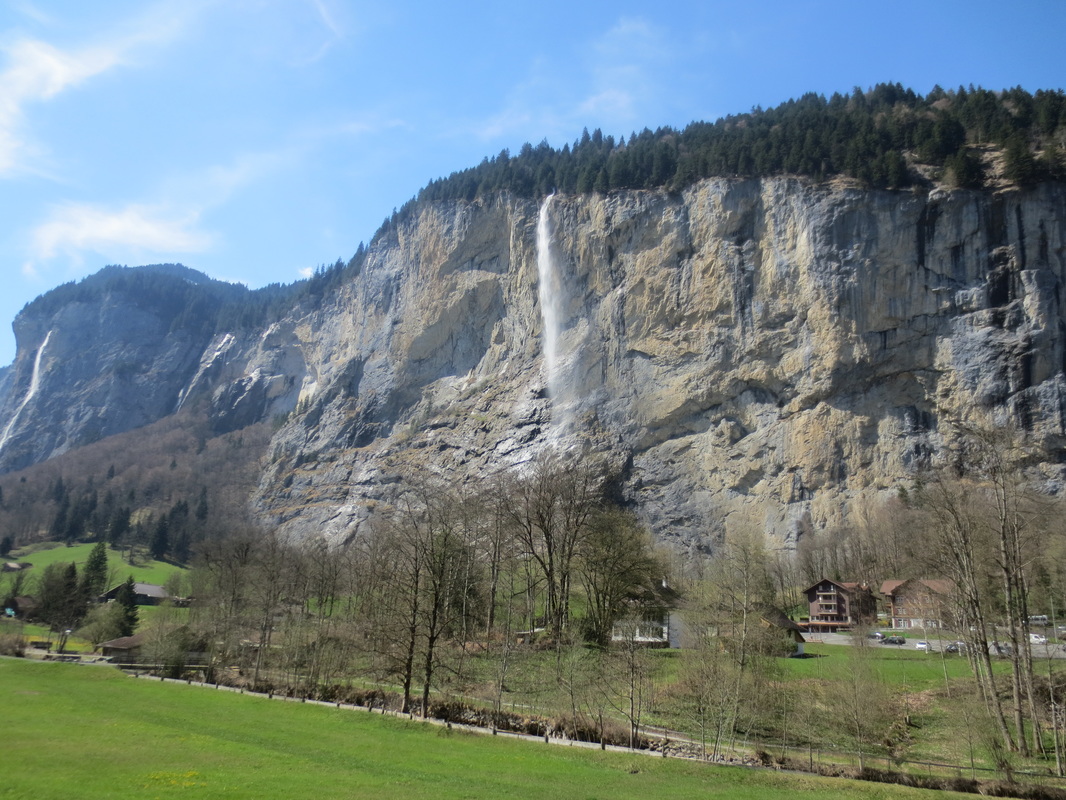
A little wind today and the Staubbach Falls are spraying a wide mist as they tumble down in this between-season time. The sun for many hours on the balcony, from the long daylight saving days makes lazing with one’s feet up on the railing an easy activity.
While the trees are not yet dressed, the fish are easily seen and buzy in the Lüterbach stream below the balcony. Some local boys come to try their luck fishing in the Weisse Lütschine (White Lütschine) opposite the apartment in the image above. Their nets and rods give them lots of fun but they went home with an empty bucket. The Weisse Lütschine has several tributaries that you can see as you walk along the path opposite the apartment heading up towards Stechelberg. Many named and unnamed gushes from the massive high walls as waterfalls down the steep cliffs. One is the into the Staubbach Falls and also the Trümmelbach Falls (the water fall inside the mountain you must visit) and the Schmadribachfall. The highest waterfall in Switzerland is here, the Mürrenbachfall, with a height of 417 meters that enters into this Weisse Lütschine. Is there a Black Lütschine? Yes ! The Schwarze Lütschine, or Black Lütschine, flows from Grindelwald to Zweilütschinen or Two Lütschine. You can see the two rivers mixing their colours under the bridge by this train station of the same name. Fund rafting experience is to be had from down the Schwarze Lütschine while the Weisse Lütschine challenges solo canoeists who begin their adventure opposite the balcony of the apartment. They are quickly out of sight and we often wonder what that would be like. The spring flowers are bursting out. Blues, yellows and whites, making a carpet on the meadows. See the heart in this group of flowers? What a picture, I couldn’t believe it. It is a great time for holiday accommodation as the village is not buzy and there are no crowds and everything feels fresh and the air is warm. Yes there are some rainy days, but that makes the grass green and I saw the first cows let out today from their winter stalls. They were crazy hungry for that new green grass they have missed all winter while being indoors. The variety of flowers and grasses in the meadows is one of the secrets to the flavour of the milk and cheeses made in the Lauterbrunnen Valley. We walked up to Wengen through these flower bursting meadows along the well-marked path and through the forest. We did not see a Chamoix or Gemse (Mountain Goat), these are the most common although we have seen them previously when they get surprised and are caught loafing off in the shadows when a person comes by on the trail. Then they spring in a flash and a rush past you as you wonder “what was that?’. There are a few of the larger Reh Deer and occasionally an Ibex or Steinbock you can see in the cliffs. Although there is a hunting season, there is plenty of fodder on the slopes for all. Wengen is a “must see” visit with another Bäckeri (bakery) with delicious cakes, bread and sandwiches. Take your purchases to the seats at the lookout by the church to enjoy the most spectacular view of Lauterbrunnen. Need a few groceries for dinner? There is another Coop supermarket, prices the same as the ones in Lauterbrunnen and Interaken, so one canbuy more fresh bread and cheese before walking down the other path to Lauterbrunnen. Being holiday means not so much cooking but since it is still light until late, we often eat supper on the balcony. Our kitchen has most culinary tools one could need and tonight I prepared sautéed mushrooms and zucchini with local Lauterbruunen butter then steamed with lashings of quark #. Served over spiral pasta with super diced thinned sliced local ham from the Metzgerei (Burcher) in Lauterbrunnen. Fast, easy and delicious! – Guten Apetit! # Quark is amazing. It is a fresh acid-set cheese. Traditional it is made without rennet, but in sometimes rennet is added. Low fat (wow so lucky) like yoghurt in calories, it is smooth, soft, white and thicker than cream but not fatty. One can use it in everything. From making a dip, spreading on crackers or with vegetables, to making soup, stirring into vegetables, which I did tonight, or topped with honey for breakfast, yumo! When you visit the stunning Staubbach Falls that you have been watching mesmerized from the dining table of Eyhus 5, you will find a beautiful poem written on a plaque there. Song of the Spirits over the Waters was written between 9 to 11th October 1779 when the author, Johann Wolfgang von Goethe was on his second visit to Lauterbrunnen. It was published ten years later in 1789 as a six-stanza poem and is categorised in poetry terms as a lyric and thought genre. The soul of man Is like the water: From heaven comes, To heaven it rises, And down again To the earth it must, Eternally changing. Flowing from the high, steep rock face The pure ray, Then it dusts sweetly In cloud waves To the smooth rock, And easily received, It fades disguised, Leisrauschend down to the depth. If cliffs loom The fall meet, Foams he angrily Gradually the abyss. In shallow bed he creeps up the meadow valley, And in the smooth lake graze her countenance All stars. Wind is the wave Wind mixes from the bottom Foaming waves. Soul of man, how are you like the water! Fate of man, how are you like the wind! Wikipedia says of the poem: "Goethe draws a comparison between the elements of nature and human existence; In concrete terms, he contrasts the human soul with the element of water and calls similarities between the two. The main theme is the transience of human life. The wind embodies the predestination of life. While the soul of man approaches the inevitable end of life, fate is alienated, and any attempt by humans to take it in their own hands can only fail." Inspired by this poem, in 1820, the music composer Franz Schubert composed a compelling 10 minute orchestral piece; “Gesang der Geister über den Wassern" You can here the piece here: EMPA design Materials and Technologies for a Sustainable Future.
EMPA began as the “Building Materials Testing Institute” in the cellars of Zurich’s Federal Polytechnical School (now ETH Zurich) in 1880. Of course there is a German acronym here. EMPA is the short version for Eidgenössische Materialprüfungs- und Forschungsanstalt. What does sustainability look like in practice? How does it actually work? What’s different from the world we live in today? And, perhaps most importantly, what are the trade-offs? Walking and biking might be the most sustainable forms of transportation, but they’re probably not the most time-efficient if you need to drive 10 miles across town for work or an appointment. No matter how different we want the future to be, we can’t simply ignore the way people actually live today. We cannot simply wish for a world we want. Regardless of what sustainability looks like for you, EMPA have just succeeded in making a lock that is made of printed, transparent electronics. So that only authorized persons know where to enter the access code. The special sensor surface material cannot be seen by the human eye and can be positioned in suitable locations, such as above a door hinge. Says EMPA researcher Evgeniia Gilshtein, "the circuits can just as easily be positioned on a pane of glass or a curved door handle." Read about it here www.empa.ch/web/s604/transparent-security We all know that slight rubbing that we try and ignore. We hope it will go away. We think maybe it’s just wrinkle in our sock. But we want to ski another run before making a detailed and time consuming inspection that will steal from our precious skiing time. Alas, during our delay, a bubble has formed.
Our skin consists of several layers that usually interlock with one another through fine structures. The upper or outer skin is called the epidermis. Underneath lies the dermis, in which the hair roots and sweat glands are located. The lowest layer, which is still counted as part of the skin, is subcutaneous tissue which contains the blood vessels, among other things. Whenever something rubs repeatedly, along with warmth and humidity, the interlocking skin layers loosen after a while and tissue fluid flows into the newly created spaces. Voila a bubble is born. When deeper layers of the skin loosen, blood can also flow in. Although the liquid now protects the deeper skin layers from even more pressure and damage, the pressure in the tissue is increased. This triggers the “pain” signal to the brain. So avoiding friction of any kind is the best prevention. 1 Footwear must fit well when feet are warm to hot and have swollen. That means no pressure points. And no slip points, such as heel movement. When buying ski boots, if you cannot get a specialist boot fitter, tya and spend as much time in your boots before buying them. An hour in the store is not long enough. Some stores will let you take them home so you can wear them for 6 hours while binge watching Netflix. 2 The right sport socks – the best friends of your feet and they can prevent blisters by keeping the foot dry. Sock size must fit perfectly with no creases. Socks including merino wool improve the water absorption and still feel dry to the touch. No cotton socks! Running, hiking and skiing socks are simply designed differently. Special “anti-blister“ socks have a double-layered, which means that the inner and outer socks can move in opposite directions so that the sock rubs against the sock and not on the skin. Clever idea but I haven’t tried them. People say an under sock such as a compression sock can help. I prefer 1 layer as my feet swell and I like a tight boot fit. 3 Foot conditioning can help. Do you wear bare feet at home? That can help to firm up the skin. Ensuring toenails are clipped short will help reduce pressure points. 4 Using Tape in areas you know will blister can help. Ensure no wrinkles when you tape onto clean dry skin. Better to regularly get the best fitting boots. If you ski hard more than 20 days a season, then you need new boots every 2 years. Forget second-hand boots, you’re feet are worth more than that. I did that when I was desperate to ski and I skied in jeans so I could afford to buy my lift ticket. Here are some ideas for reducing the risk of ski and pole theft while you are enjoying a break inside a cosy mountain side Café.
On 5 December, the new Eiger Express tricable gondola takes its first trip from Grindelwald Terminal to the Eiger Glacier station in just 15 minutes. Skiers will love this speed to the slopes. To the top in just 15 Minutes. The opening is right on Schedule see Nov 2018 Blog and it will make a huge difference in poor weather as well. The new station has plenty of dry areas that are a comfort in bad weather.
My Swtizerland updates Co Vid safety needs: "In Switzerland, there is an extensive obligation to wear masks: in public transport and in all public spaces where it is not possible to keep a distance (including outside areas of restaurants, of shops, in pedestrian zones, etc.). The information and entry requirements for all nationals can be found here More information When entering Switzerland from certain areas, it is compulsory to report to the cantonal authorities and to go into quarantine for ten days. The Federal Office of Public Health (FOPH) maintains a continuously updated list of these areas. The persons concerned will be informed in cross-border means of transport and at border crossings. Important: Travellers must inquire with their national authorities about the exact travel conditions before starting their trip. There is a Swiss app . Also this makes it a fast ride to the top to begin this summer Eiger walk. Photo: https://www.jungfrau.ch The study of glaciers is called Glaciology and taken from the Latin meaning 'frost ice'. Wikipedia defines glaciers as"an extended mass of ice formed from snow falling and accumulating over a long period of time; glaciers move very slowly, either descending from high mountains, as in valley glaciers, or moving outward from centres of accumulation". Stretching over 23 kilometres, the Aletsch Glacier in canton Valais is the longest in Europe, measuring 1.5 kilometres wide on average and 900 metres at its thickest point.
A train ride from Lauterbrunnen up to Jungfrau Joch will give you this most spectacular view. From its source in the Jungfrau mountain region at over 4,000 metres, the glacier flows down the valley at speeds of up to 200m a year. But in recent times it has also been beating a major retreat. Up here at 2,333 metres, you cannot hear the steady drip of melting ice down below. But over the years the cumulative effect has been devastating. “Over the past 40 years, the end of the glacier has shrunk by 1,300 metres,” explains Laudo Albrecht, director of Pro Natura’s Aletsch Centre, located near Riederalp in the heart of the Aletsch region. “But it’s not just shorter; it’s also 200m thinner.” see https://www.pronatura-aletsch.ch/de Over the next 50-100 years Switzerland could face a three-degree Celsius temperature increase due to climate change. Researchers believe that alpine plants could face not only warmer temperatures, but also deadly competition from unfamiliar species. Fortunately, no notable changes had been witnessed so far. The Hardergrat trail is a 24 km ridge hike, starting from Harder Klum at Interlaken. “GRAT” means ridge in German and Harder is only a name but it is a “harder ridge” 😊
This spectacular ridgewalk is ONLY for people who do not get dizzy as you are walking along the exposed ridge most of the way. The ridge drops steeply on both sides, like 1500m steep!, that’s steep. There is no water or food so you must take it all yourself and start before sunrise as it’s over 10 hours long with a 3000m elevation gain. You must also plan your day and read the map before your go, if you don't make the Brienzer Rothorn’s last train down to Brienz you will have another 1700m down, probably in the dark. NEVER DO THIS PATH IN THE WET. But a “taster thrill” walk exists. Catch the funicular from Interlaken to Harder Klum. Then from Harder Kulm follow the sign to Augstmatthorn (3 hours and 30 minutes) to the feet of Suggiture is mostly through the forest walking up about 400m of elevation taking around 80 minutes to reach to “the feet” of Suggiture. Coming out of the forest you will see the Suggiture. Climbing up the Suggiture is steep and very rocky, but also very short. It is about 150 m of elevation gain and about 30 min to reach Suggiture. (photo below) From Suggiture to Augstmatthorn is walking along the ridge . From Augstmatthorn and way back you can walk down the steep trail to Lombach (about 45 minutes) and then walk another 1-1.5 hour to Habkern and then take a bus to Interlaken. P.s. be sure to check the bus schedule as they are infrequent. This “Taster thrill” walk whet your appetite to prepare for the whole 24 kilometers. Yes, but with a permit. There are lovely lake or brown trout there. Only from Mid-March to end September. You must be able to agree to fishing by the methods stipulated by the Bern Fisheries department and it is quite costly.
New regulations from 1 January 2020 say that a Bern fishing license can in principle be obtained by anyone - with or without a residence in the canton. Although you can buy online, it will be posted otherwise you can buy from Tourism office in Lauterbrunnen. The fee system is a bit complex, but basically a weekly permit is around 100 CHF. It is personal and non-transferable and you need to report back the catch statistics. Each person who is fishing needs a license even if they share the rod except for kids under 9 if their accompanying adult has a permit. You can find information here: www.vol.be.ch/vol/de/index/natur/fischerei/angelfischerei/patente/preise.html While it could all sound a bit hard, the good news is fishing without licence is allowed in Lake Brienz and Lake Thun. There you can find your own nook around the lake, spread a blanket on the grass and enjoy a picnic while you wait for your catch. Of course there are some rules to observe such as fishing from the shore with a single rod and only one single barb- less hook is allowed. Naturally limits to numbers and sizes apply, so best to investigate the above website further. In Lauterbrunnen you will wish you had more time to stay. Every visit is never long enough. So you need a precision time piece to ensure you keep good time and make the most of your time here.
Everyone knows of the heritage Switzerland has for watchmaking. Perhaps in the long dark winters before there was radio and Television, craft workers had more time to perfect their profession and less distractions such as the Internet offers. All of the top 10 oldest luxury watchmakers in the world are Swiss (although two were founded in other countries). Just what is it about Switzerland that produces such fine watchmakers? It’s often said the secret to the Swiss industry’s rise was établissage, the system of assembling watches from parts made by many different craftsmen working independently. It took off in the early 1800s just when Switzerland’s former textile makers were looking for something more modern to do in the long winter months, and the country quickly took a lead over other countries who were still using a one man, one watch system. It also has to do with a particularly Swiss sense of perfection. Where does this sense come from? perhaps when you look around at the beautiful snow capped Jungfrau region, you will get a sense of the perfection in nature. The perfection of snow as it lays clean and white and everything looks in order. Maybe it is the Alpine stillness or the ever-so-slow moving glaciers that gives the air of timelessness. Time to such in a deep breath of fresh air and feel its wellness in one's lungs. Deep, clean air. Vast stretches of ice and snow. An environment where one does not feel the need to hurry. Maybe it is such and atmosphere as this, where time is allowed to make things with perfection and beauty as an end goals. Like nature. Every timepiece that leaves the Carl F. Bucherer workshops (since 1888), to name one long-established Swiss watchmaker, is a miniature miracle in which more than 100 components seamlessly inter mesh. The 10 oldest luxury watch brands: Carl F. Bucherer – Lucerne, 1888 Audemars Piguet – Vallée de Joux, 1875 Waltham – Massachusetts, 1850 (now made in Marin-Epagnier) Patek Philippe – Geneva, 1839 Longines – Saint Imier, 1832 Gallet & Co – Geneva, 1826 Breguet – Paris, 1775 (now made in Vallée de Joux) Vacheron Constantin – Geneva, 1755 Favre-Leuba – Le Locle, 1737 Blancpain – Villeret, 1735 Photo: Manero Peripheral watch by Carl F. Bucherer 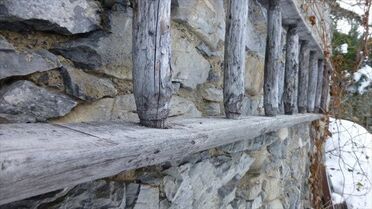 There are much evidence from the early Walser communities throughout the Swiss Alpine regions. Such as famous walking paths that originated from the Walsers as they traveled and moved their animals as part of their livelihood. Who were these Walser folk? The Walser were colonists. They moved out of the Valais Rhone Valley in the region 14th and 15th Centuries around 700 years ago and were given special land management and grazing rights in the high altitude settlement areas. The Valais people themselves are not counted among the Walsers. Dr. Johannes Führer defined the group: "Walser is the name given to the inhabitants of the historic Walser settlements in the heights of the Alps, in which the language, culture, economy and historical awareness of the Walser were or are alive in the 20th century." The long, snowy winters made these folk skilled in being able to store forage for their animals. The foundations of their barns were made from a wall built from unworked stones. A specific building style, the wooden ledgers of the stable and the round timber are connected in a log building, the walls are reinforced with stakes and tied to wooden cramps. Photo by Gloeggli in Gimmelwald. Several Walser communities came to the Berner Oberland region and some preserved Walser wooden barn buildings can be seen in Gimmelwald and Mürren. Nowadays the barns remain mostly empty since modern farming mostly uses centralized large stables. An old and empty Walser barn in Safiental (GR) has been renovated and opened to the public with the support of a public trust, to show an example for perfect preservation. As well as Gimmelwald and Mürren there were Walser settlements in Trachsellauenen (behind Stechelberg), ‘Ammerten’, (higher up above Trachsellauenen behind Stechelberg) and Walser farms in the Sefinental valley. Ammerton or Ammerten was a large settlement in the Ammertental behind Stechelberg. When and why this settlement was abandoned is unknown. It was mentioned in a choir manual from 1762 and Marc Théodore Bourrit from Geneva wrote in 1787: "Ammerten is still an almost lost home for people", and around the middle of the 19th century Peter Ober wrote “The village is no longer ". Perhaps the wave of emigration to the United States in the middle of the 18th century, included members of the Walser communities from the Berner Oberland region. Photo below: “Rear Lauterbrunnen valley with Undri Ammerta and Obri Ammerta on the slope in the foreground to the left of the center of the picture” Source: https://de.wikipedia.org/wiki/Amerton 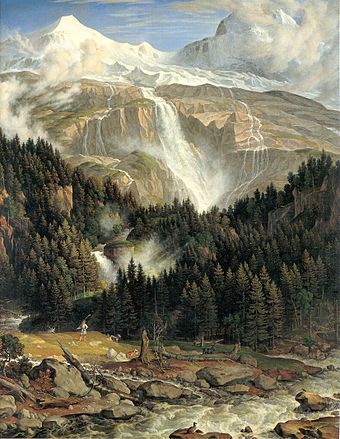 Visitors to the Lauterbunnen Valley, most often come to see the world famous Staubbach and Trummelbach Falls They will also take many photos of the Weißse Lütchine river that races almost down the middle of the valley getting wider and fatter as it is fed by the many contributing tributaries. While the Weiße Lütchine river flows down from the Sefinen-Gimmelwald-Mürren side, there is another very magnificent but overlooked waterfall at the junction in Stechelberg. These two mighty rivers meet and just like the Stechelberg Hotel is a great place to meet up and enjoy a meal in the garden or terrace, you can sit there and be amazed at the waterfalls all around. Including this Other Waterfall. This ‘Other River’, was made famous in art by artist Joseph Anton Koch (1821/1822) who captured the sensationalism of its waterfall. .Classifed in the Worldwaterfalldatabase.com as number 642, the stunning Schmadribachfall is a 270 metre waterfall with several steps in the Schmadribach behind Stechberg. The Schmadribach rises from the Breithorn glacier and the Schmadrig glacier at the foot of Grosshorn and Breithorn and plunges over limestone benches into the rearmost Lauterbrunnen valley. It is possible to safely walk up along the steep side of this beauty of nature via the UNESCO mountain pathway from Stechelberg. It is around 12.9 kilometres out and back. Or make a longer day walk and climb from Stechelberg to the Berggasthaus Obersteinberg. Here at this high moutain hostel retreat it is Ipossible to stay the night in this candle lit retreat if you book in advance, or you can walk the steep path back down to Stechelberg. A long but rewarding day. Photo: Sylvia Furrer Helping kids to accept new foods involves letting them play with it, to get messy, to watch it grow, participate in planting the garden. Food is naturally a sensory experience not just some sticking it on a fork. Although Fondue involves putting food on the fork, it is about playing with food and having fun. Listed as a national food dish of Switzerland, Fondue is something everyone needs to try at least once in their life. Despite being very rich and filling, a Cheese Fondue is a taste sensation of heavenly cheeses that will explode your taste buds. It takes many hours to gentle compile and simmer the base. Usually a blend of gorgeous alpine cheeses that taste delicious on their own. It is a a half day affair to prepare properly. A little garlic here, a little nutmeg and dark spices there and a generous blend of wines that lose their alcohol content in the very long stirring process. When swooshing your long stick and bread cube in the liquidy cheese, try not to lose your bread and rather than mopping up the last bit of melted cheese from the bottom of the pot, let the flame continue to cook the cheese on the bottom of the pot so that a dark crust forms. This crust is called the religieuse and thought to be the end treat.
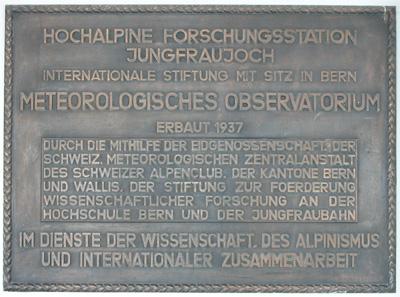 Not many people know about the significant research station on the Jungfraujoch. Built in 1937, it provides the infrastructure and support for scientific research that must be carried out at an altitude of 3’000-3’700 meters above sea level or for which a high alpine climate and environment are necessary. The buildings include the Research Station, Sphinx Observatory at Jungfraujoch, and lab space in the former Swisscom relay station on the Jungfrau East Ridge. The High Altitude Research Stations Jungfraujoch and Gornergrat International Foundation (hfsjg) provides the necessary infrastructure such as accommodation and support for scientific work for researchers from all over the world. No research is carried out by the Foundation itself. Some of the Research topics at Jungfraujoch with photos from www.hfsjg.ch 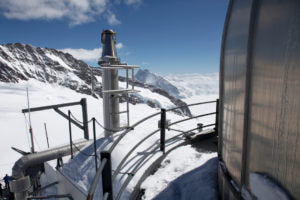 Meteorological measurements at Jungfraujoch that play an important role in the computer programs of weather forecasts as they show at what speed changes in the weather can occur. They have also identified trends of great importance as the consequences of climate change. Documenting the climate change since Jungfraujoch is far above most sources of air pollution, the High Altitude Research Station is suitable for measuring the composition of the atmosphere. 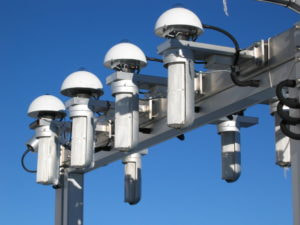 Monitoring the radiation balance: Radiation is the driving force in energy exchanges between the atmosphere, the oceans and the ground: the most direct effect of global warming is expected to be an increase of infrared radiation emitted from the atmosphere to the ground. Long-term observation of surface radiation fluxes is consequently an important part of climate change monitoring. 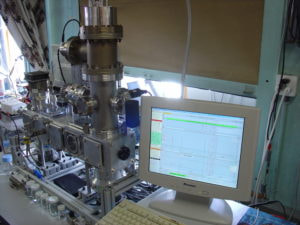 Understanding Aerosols: Since the 1990’s research to gain a better understanding of how the fine suspended particles in the air affect the climate and cloud formation. 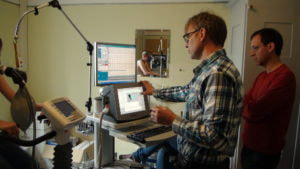 Medicine: The effects of a high-altitude stay on the human body has been a focus for many researchers. Investigations into cardiovascular systems, correlations between blood gas values, symptoms of acute altitude sickness and how heart patients handle an altitude above 3’000 meters. Although there is special accommodation for researchers at the station, there is nothing publicly available.
A day trip to the Jungfraujoch is a special day that one remembers for many years. There are diverse areas to explore such as ice caves, the views and an hour walk (maybe strenuous at altitude for some people) to the Mönch Hut in good weather also reveals the glacier world. The view of the magnificent UNESCO protected Aletsch Glacier is breath-taking. Be sure to check the weather the day before your outing for optimal photo opportunities and the walk to the Mönch Hut. Be on the first train leaving Lauterbrunnen around 7am to avoid the crowds and pre-buy a ticket in summer as they have limited capacity on the trains (around 3500 seats per day). In the homeward train journey, alighting at Eigergletscher station is well worth the side walk around to better see the Eiger Glacier. Then you can walk down to Kleine Scheidegg enjoying the views and the musical cow bells. Re-joining the train at Kleine Scheidegg before another hop off stop at Wengen for some village browsing before getting back on the train to continue to Lauterbrunnen. These side trips can make the day a full and colourful adventure. When you visit the stunning Staubbach Falls that you have been watching mesmerized from the dining table of Eyhus 5, you will find a beautiful poem written on a plaque there. Song of the Spirit over the Waters was written between 9 to 11th October 1779 when the author, Johann Wolfgang von Goethe was on his second visit to Lauterbrunnen. It was published ten years later in 1789 as a six-stanza poem and is categorised in poetry terms as a lyric and thought genre. Wikipedia says of the poem: "Goethe draws a comparison between the elements of nature and human existence; In concrete terms, he contrasts the human soul with the element of water and calls similarities between the two. The main theme is the transience of human life. The wind embodies the predestination of life. While the soul of man approaches the inevitable end of life, fate is alienated, and any attempt by humans to take it in their own hands can only fail."
Inspired by this poem, in 1820, the music composer Franz Schubert composed a compelling 10 minute orchestral piece; “Gesang der Geister über den Wassern" You can here the piece here: www.youtube.com/watch?v=KK20LMuCWx0 |
Eyhus 5
Where dreams begin for outdoor adventures in the inspiring Jungfrau region Categories
All
Archives
April 2024
|
|
Eyhus 5,
3822 Lauterbrunnen, Schweiz Email: [email protected] About Us: We love the Jungfrau Region and enjoy helping guests to plan and discover the beauty here for themselves. Summer, Winter, Spring and Autumn each have their opportunities to give inspiration in this amazing Playground. |
|
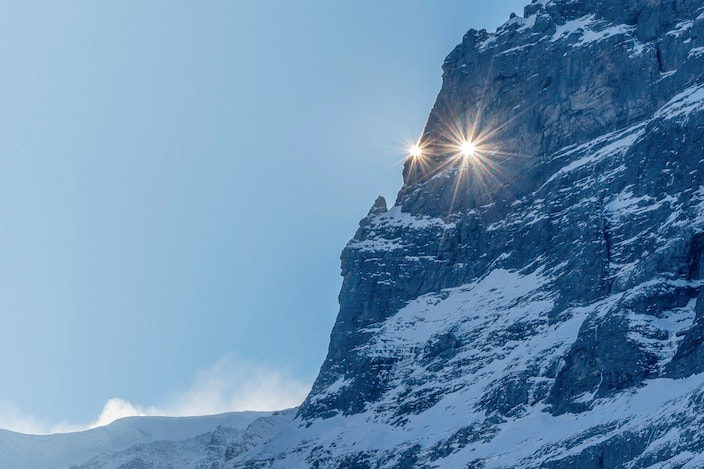
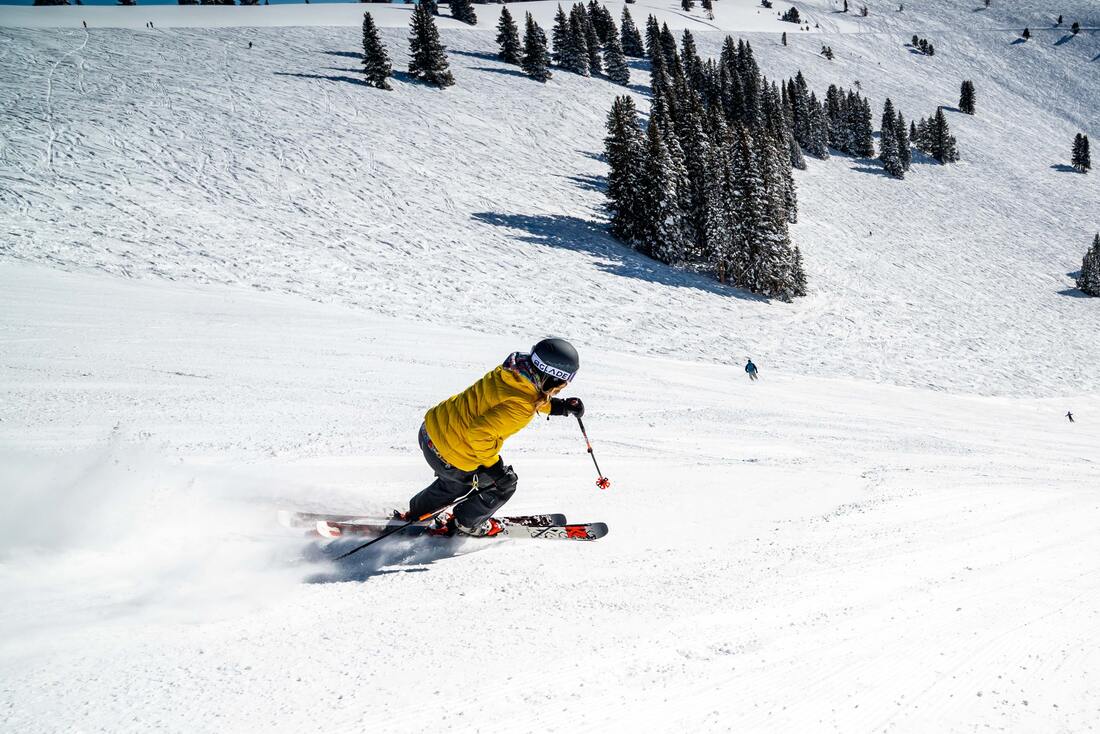
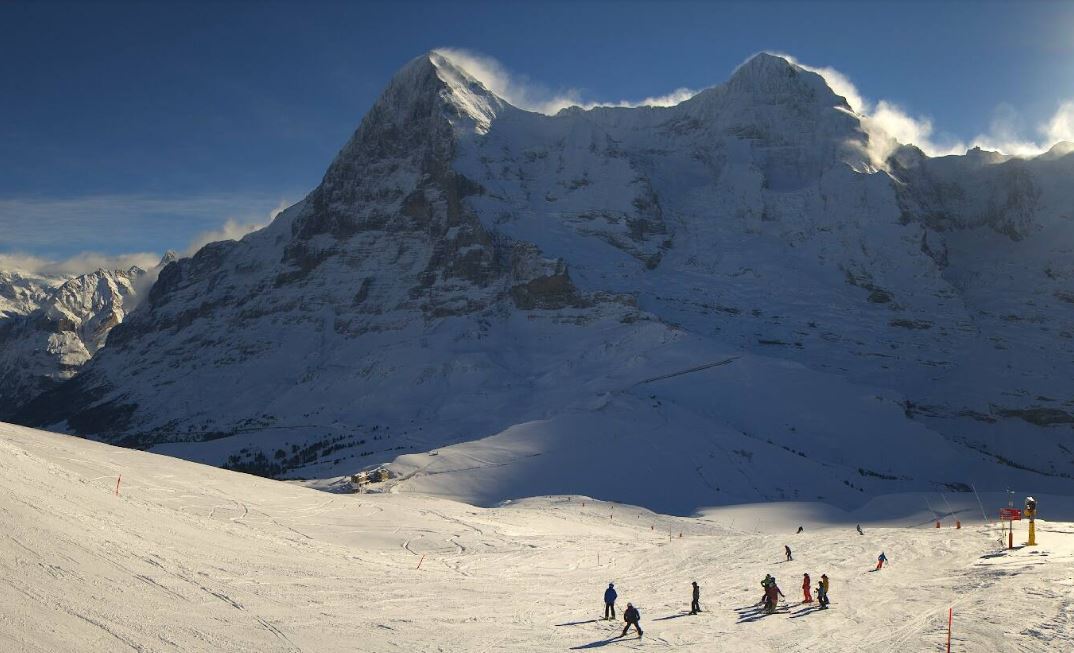
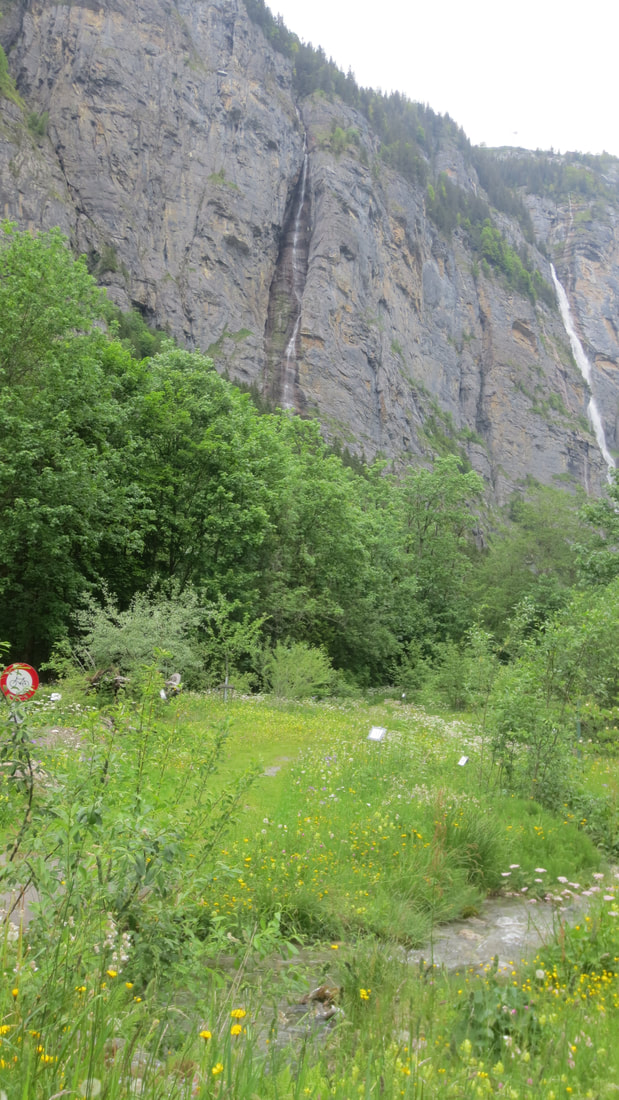
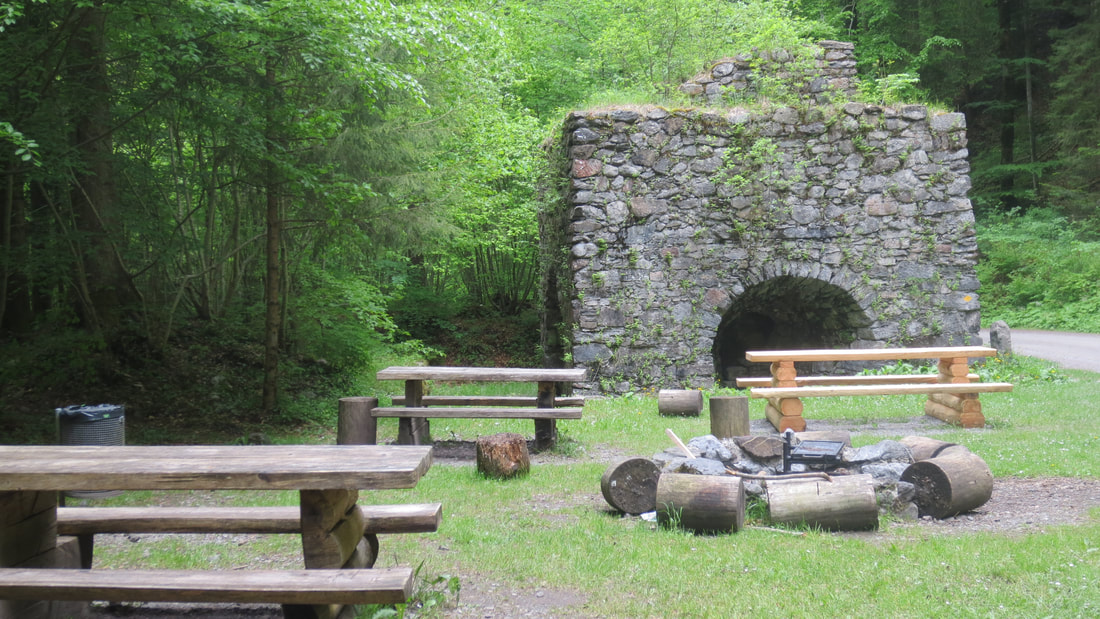
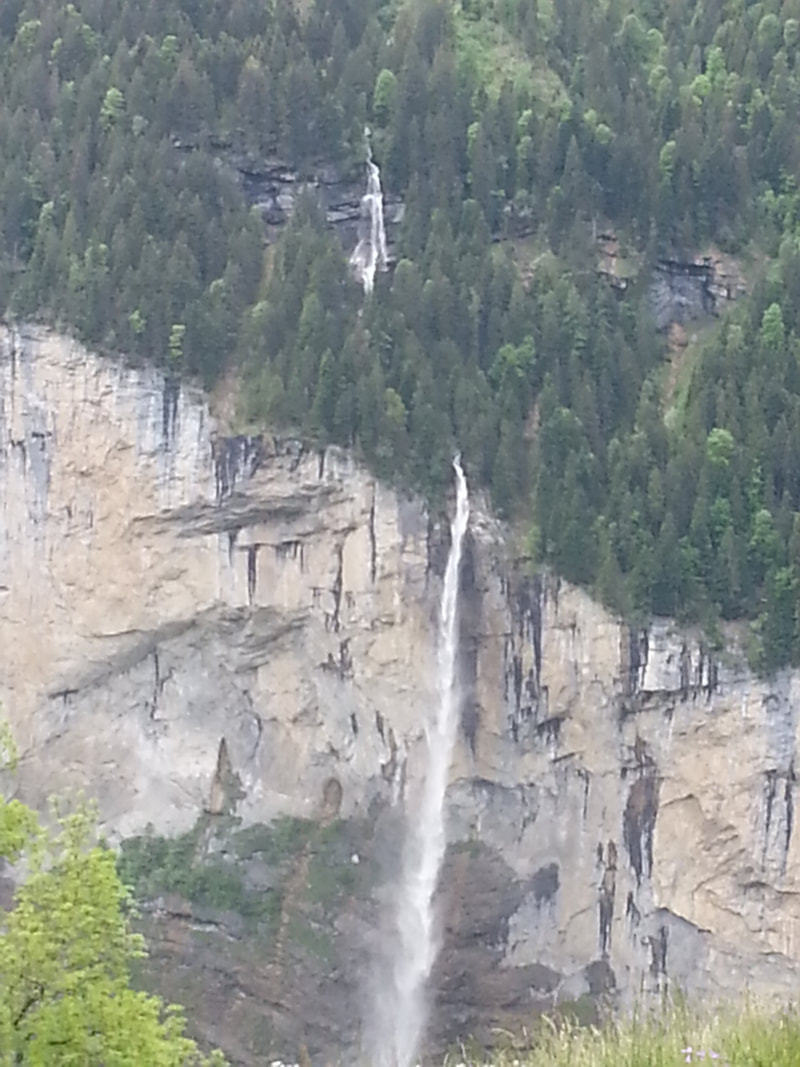

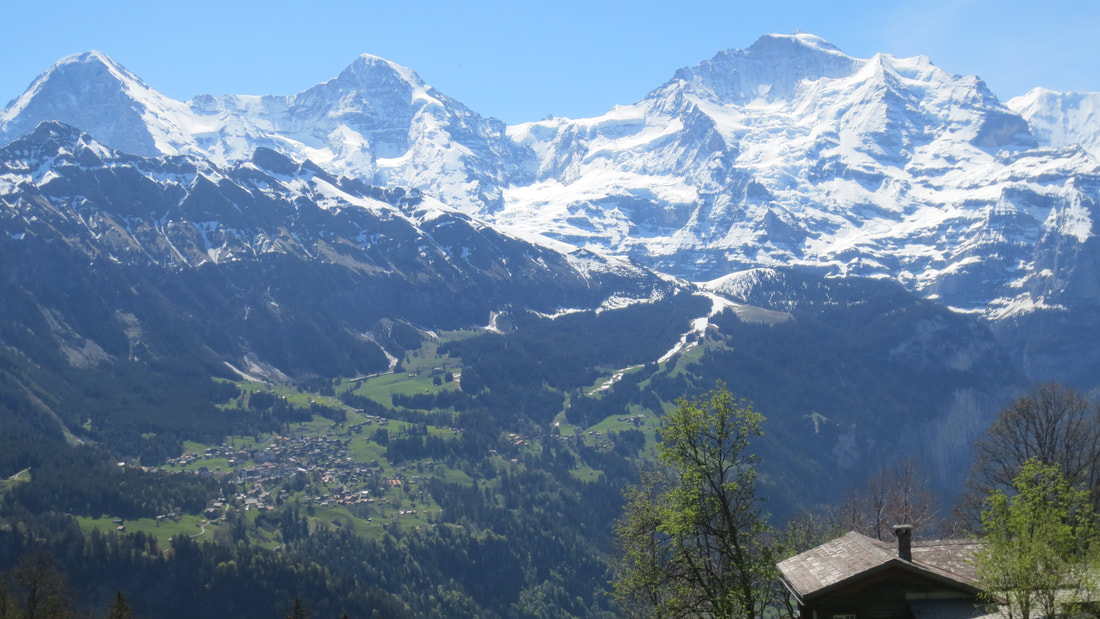
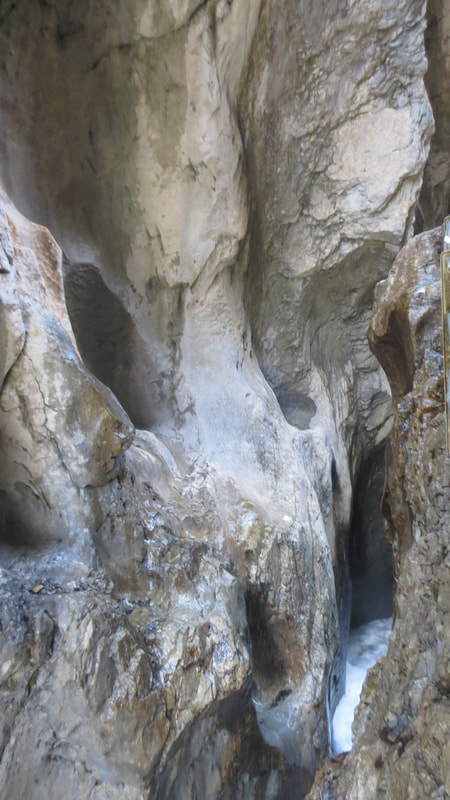
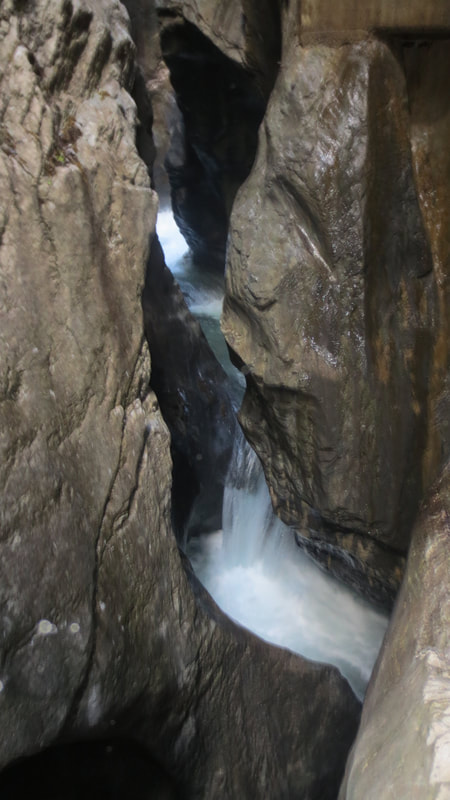
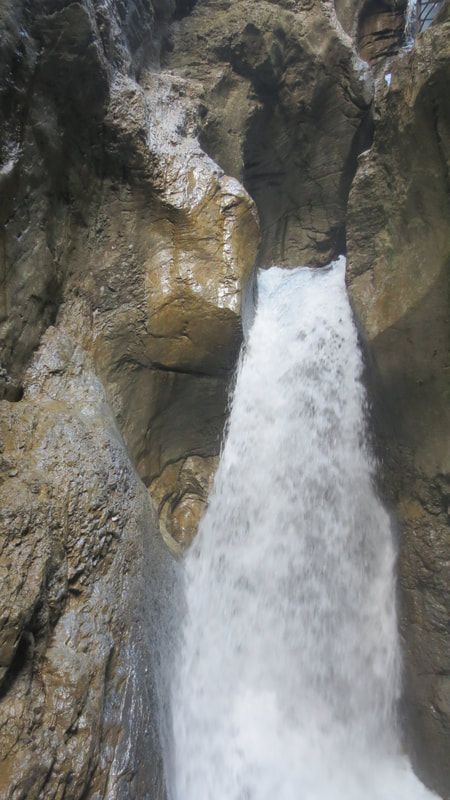

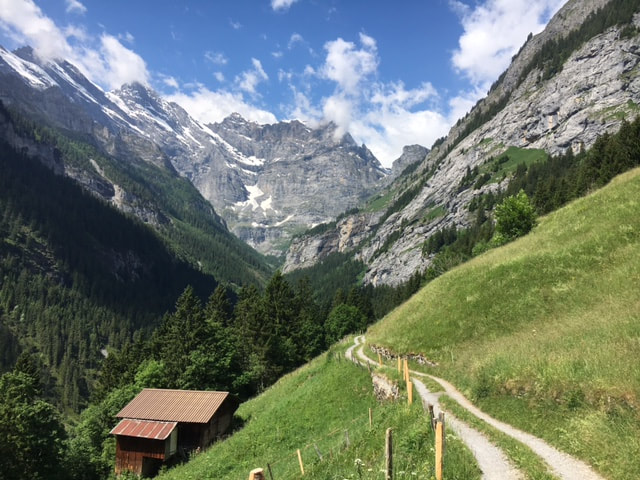
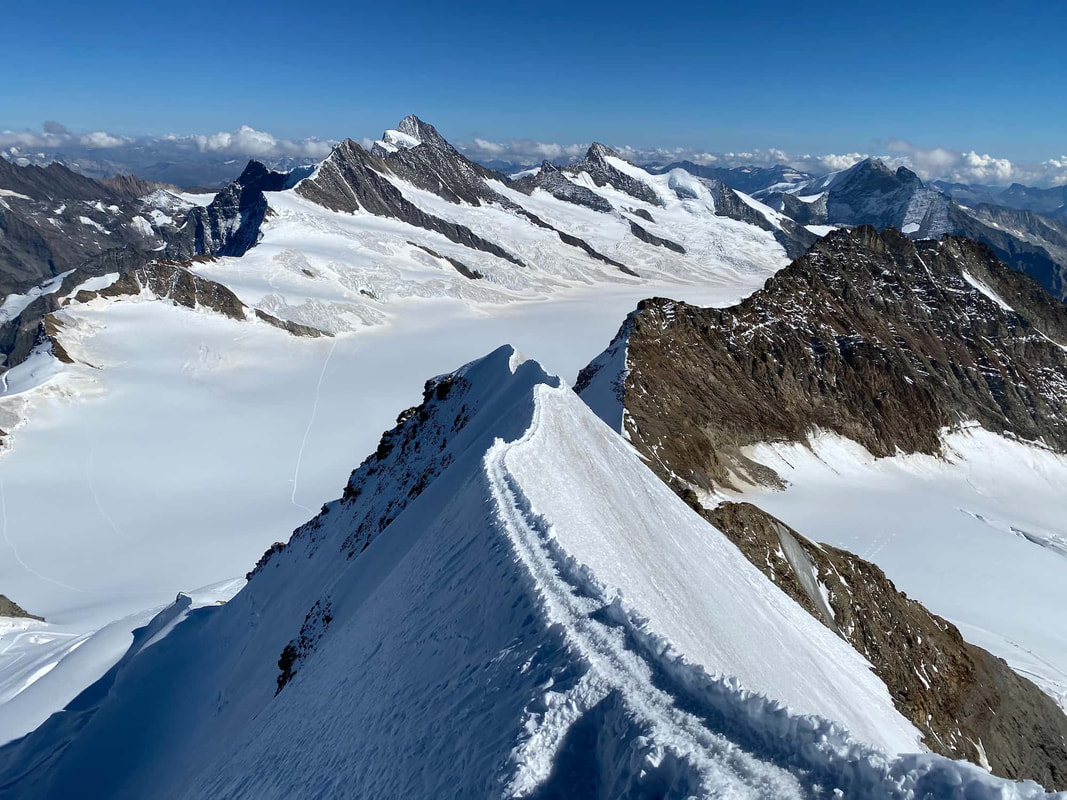
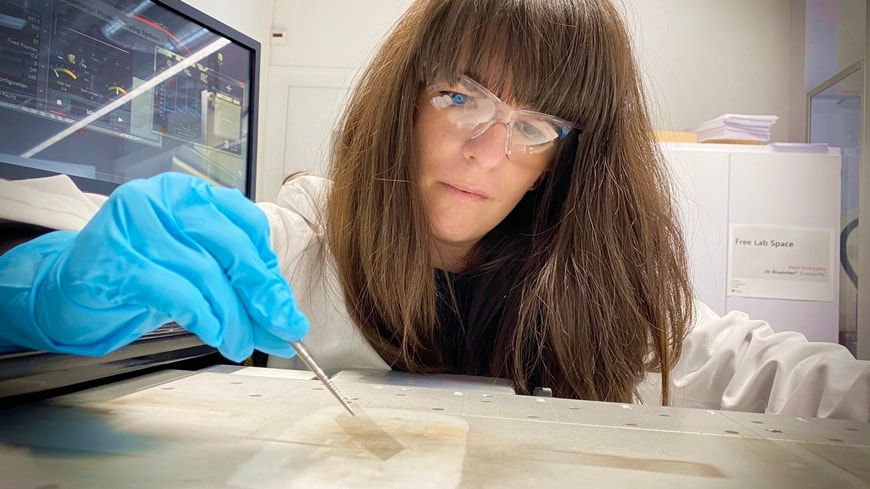
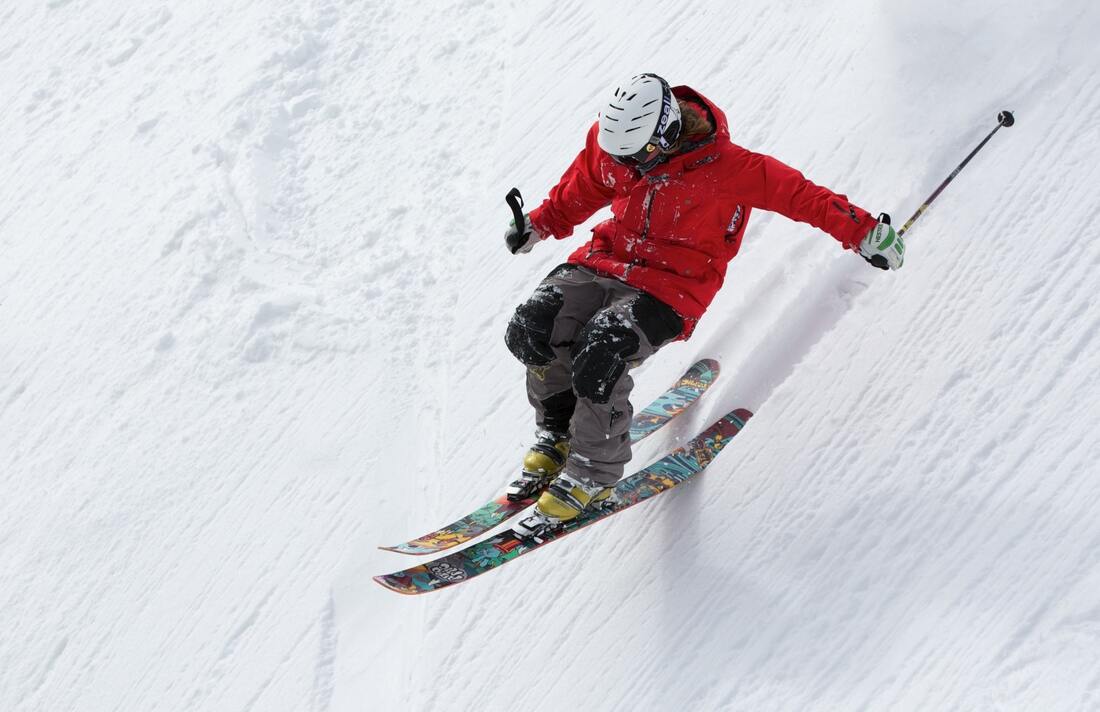
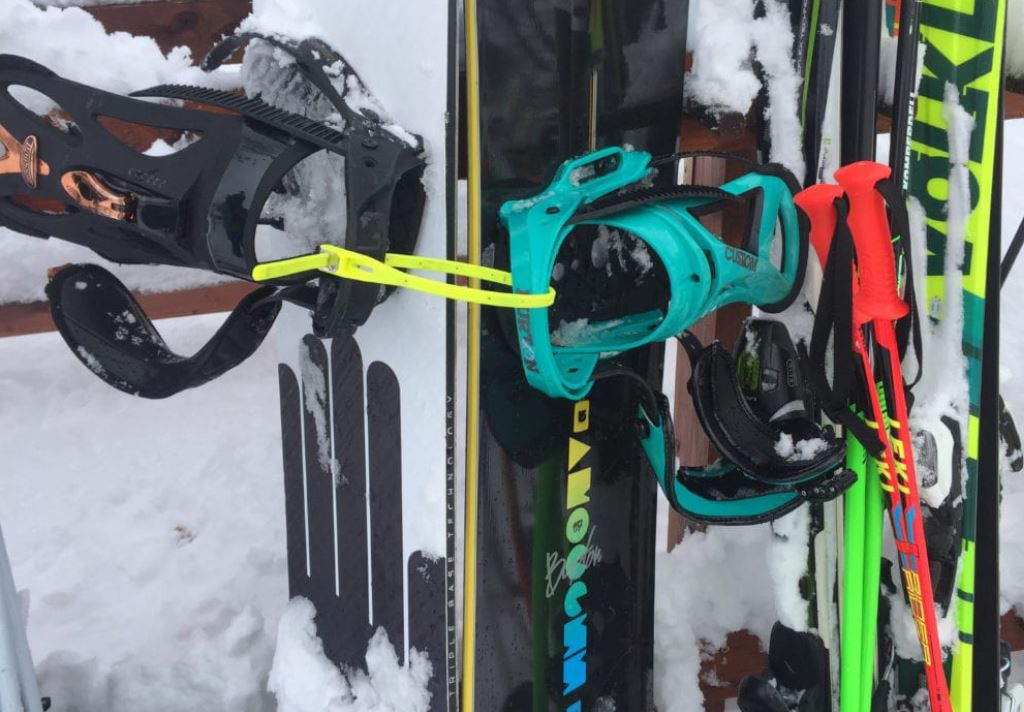
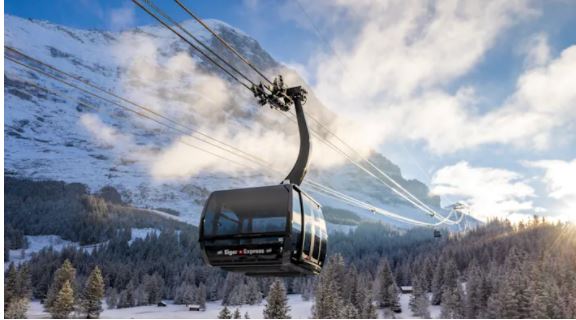
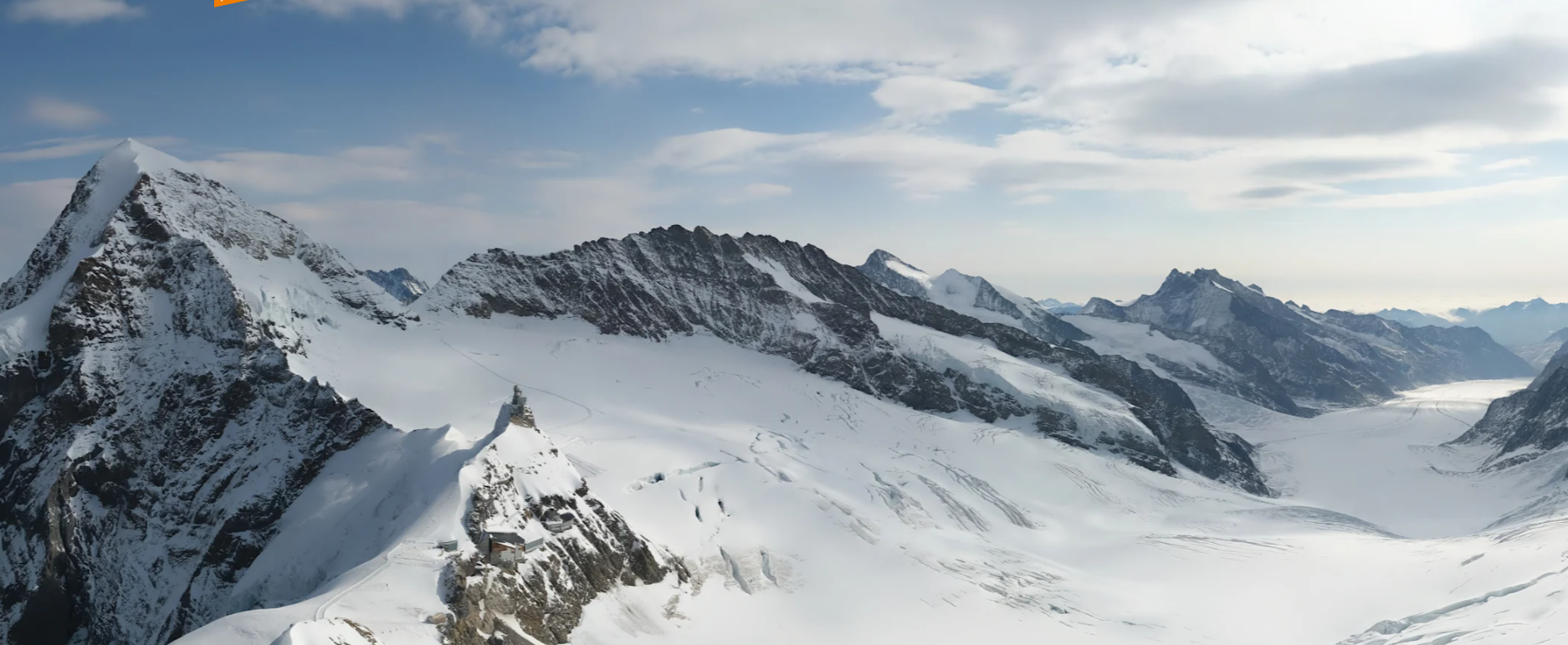
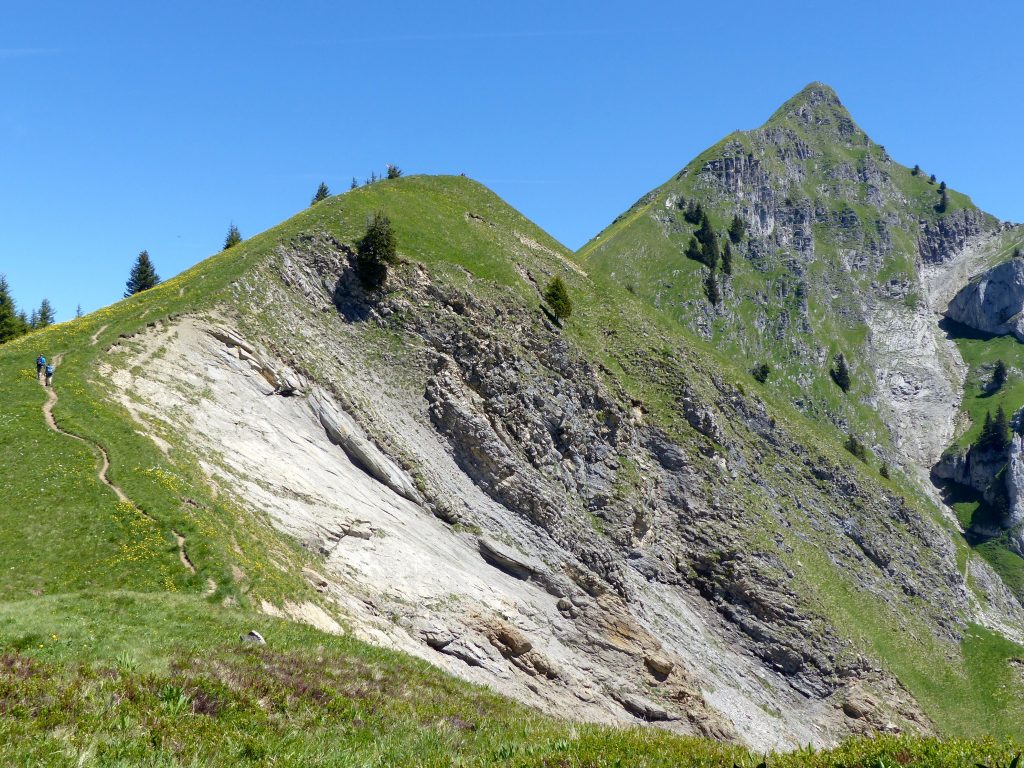

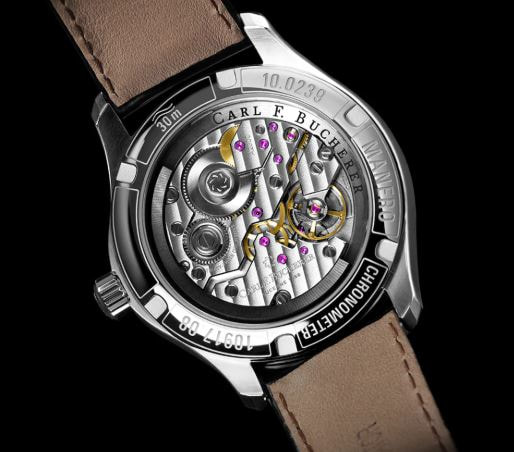
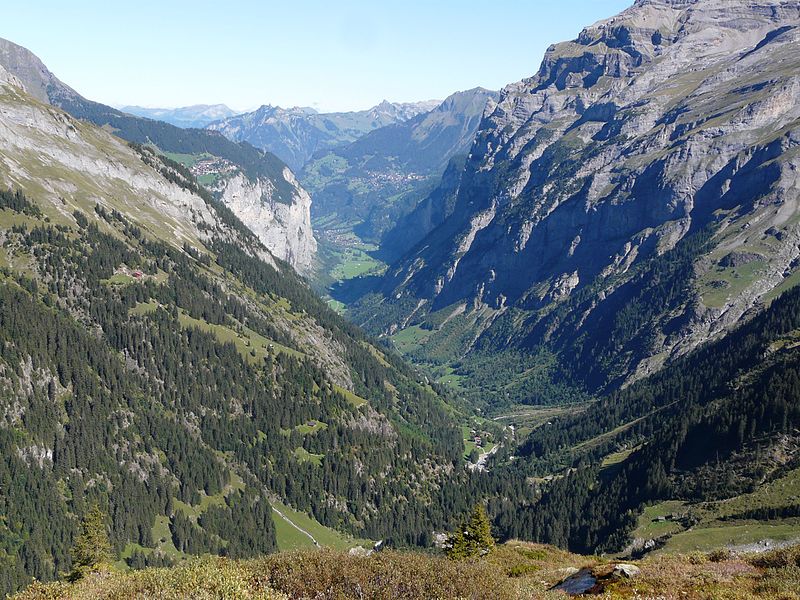
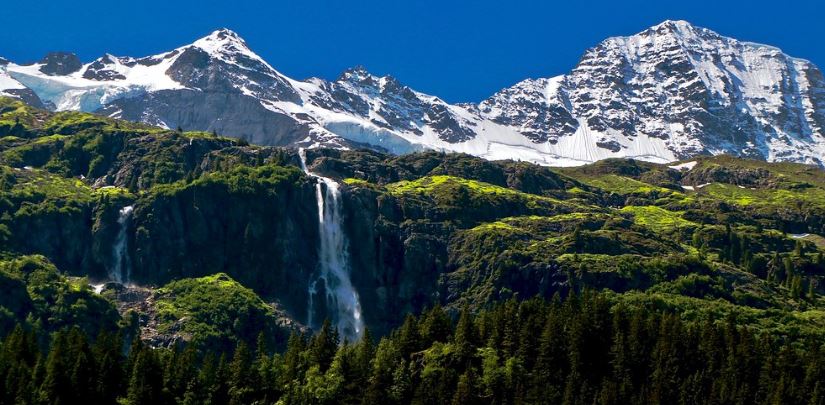
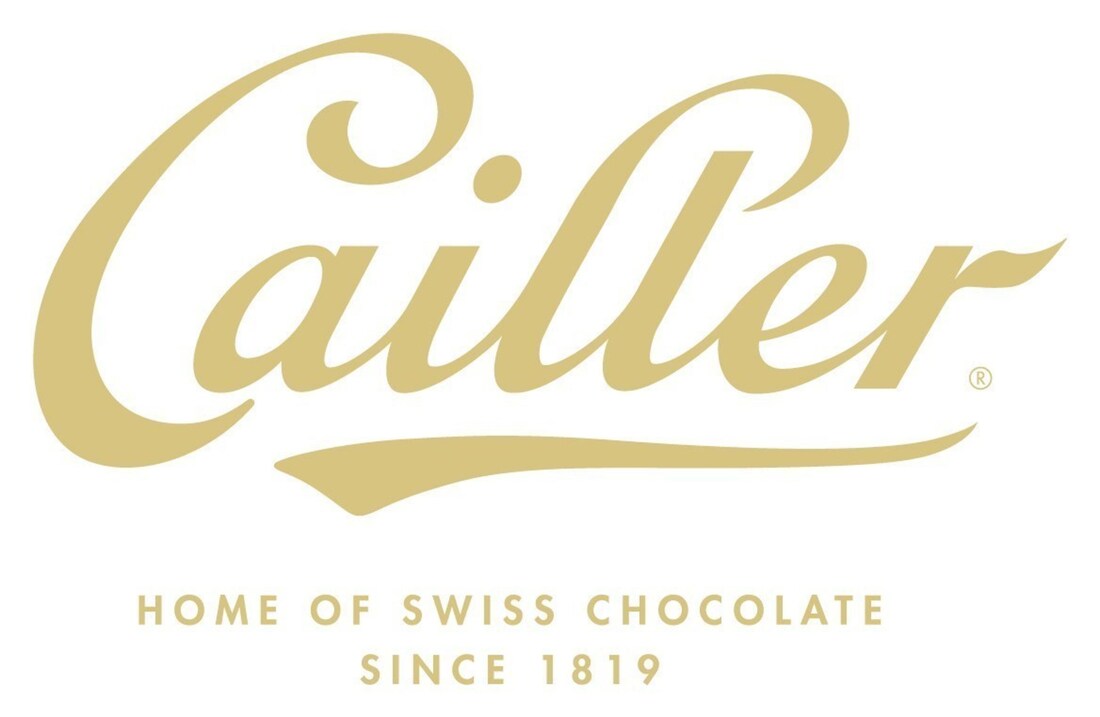
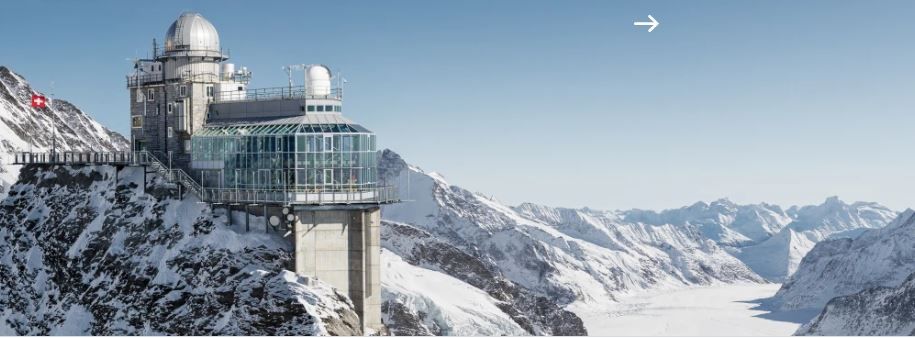

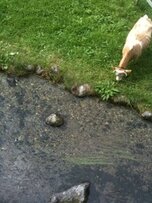
 RSS Feed
RSS Feed
